A Non-impact printer is a modern-day printer that prints high-quality pictures, characters, figures, and any document without making noise. It does not impact or press the ink ribbon against the paper to print characters or graphics. If you want to explore more about the non-impact printer, continue reading this article.
Printers are one of the most common peripheral devices of a computer. Also, they are common output devices of a computer that make the visualization of digital information (graphics or text) on paper. In other words, printers are hardware devices that generate a hard copy of any digital document.
Among the two major types of printers , non-impact printers are popular these days. Impact printers , a type of printer used widely in the early days, are obsolete in this modern era.
They made a lot of noise due to the striking of mechanical components – hammers and movable print heads on the ink ribbon. The quality of printing was not up to the mark. Also, most impact printers were limited to printing text.
Hence, there was a need for robust, noiseless printers capable of printing high-quality images and text. This led to the advent of non-impact printers.
This blog post aims to enlighten you on non-impact printers and their types and advantages, and disadvantages.
What is a Non-Impact Printer?
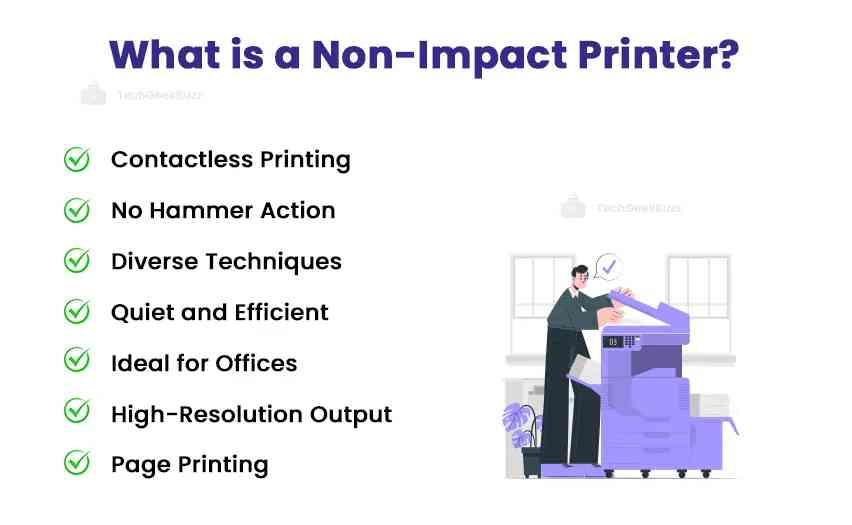
A non-impact printer is a type of printer that does not require physical contact with the paper to print the desired document. This means it does not press or impact the ink ribbon against the paper to print characters or images. In addition, unlike impact printers, a non-impact printer doesn’t use the technique of striking the hammer on print heads against the ink ribbon.
Instead, non-impact printers use different techniques to generate the desired output on paper. For instance, inkjet printers spray drops of ink on the paper to print characters or images. On the other hand, laser printers use the laser beam and electrical charge for printing.
With no striking mechanism, non-impact printers are much quieter and consume less energy than impact printers. This makes them ideal for office purposes. Additionally, they are capable of generating high-resolution prints of text and images.
Another advantage of non-impact printers over impact printers is that they have the ability to print a full page at once. Hence, we refer to them as page printers sometimes.
Characteristics of a Non-Impact Printer
The following are the remarkable characteristics of a non-impact printer:
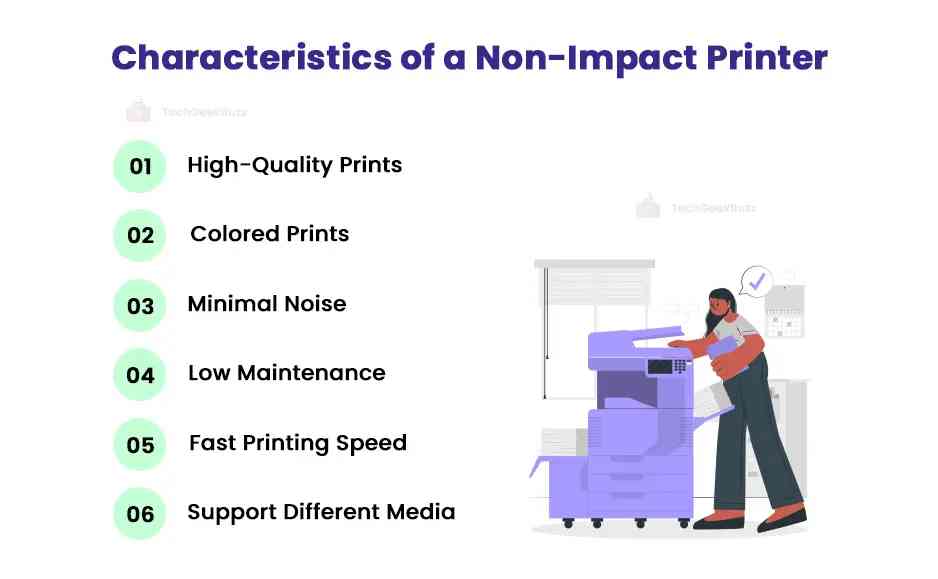
1. High-Quality Prints
Non-impact printers are known for generating high-quality prints with fine details. As these printers leverage modern technologies, such as laser and inkjet, they produce prints with resolutions of up to 1200 dpi (dots per inch). Laser and inkjet printers can accurately print every intricate detail of a graphic and even small text characters.
2. Colored Prints
With traditional printers, it was difficult to achieve colored prints. Only a dot-matrix printer could generate colored text print. However, it used the same color throughout a single print.
This is not the case with non-impact printers. Laser and inkjet printers use a broad spectrum of colors to print colored images and text. Hence, they are widely utilized to print photographs, colored documents, presentations, etc.
3. Minimal Noise
Impact printers had a striking hammer to strike movable print heads on the ink ribbon. This movement of mechanical components generated loud noises, causing disturbances.
Conversely, non-impact printers do not use this mechanism. There is no contact between the printing device and the paper. They operate quietly without making distracting sounds. Hence, this characteristic makes them suitable for office environments.
4. Low Maintenance
Compared to impact printers, non-impact printers have low maintenance. This is because there is no striking between print heads and the ink ribbon, resulting in a few mechanical failures. Additionally, you don’t have to worry about paper jams due to the misalignment of any component.
The regular maintenance involved in non-impact printers is replacing ink cartridges or toners and cleaning components.
5. Expensive
Cutting-edge technologies non-impact printers use to produce high-resolution prints make them pretty expensive. The cost of buying a non-impact printer itself is very high. Further, you must replace toners or ink cartridges if they become defective.
Though expensive, non-impact printers are reliable and have a long lifespan, making them worth investing in.
6. Fast Printing Speed
Undoubtedly, the printing speed offered by non-impact printers is unmatched. Their ability to scan and print an entire page in one go makes them faster. They can print bulk copies of a document within no time. They come with a feature of double-sided printing that facilitates the printing process.
7. Support Different Media
Besides pain paper, non-impact printers support a wide range of printing media. This includes envelopes, labels, fabrics and textiles, photo paper, cardstock, etc. However, it is essential to note that the type of media a non-impact printer supports depends on its model and features.
Types of Non-Impact Printers

Here, we have listed some of the most common types of non-impact printers. Each type has a unique printing mechanism, speed, and reliability. Let us explore them in detail below.
1. Inkjet Printers
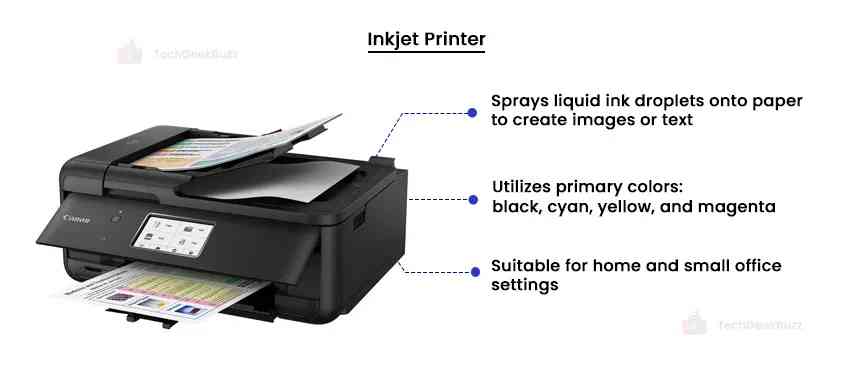
Inkjet printers are non-impact printers that leverage inkjet printing technology. This technology involves printing a digital image or text by spraying ink droplets on paper. These printers have nozzles or jets with small holes through which they spray ink droplets onto paper in a specific pattern, forming a desired shape or text.
The ink used by inkjet printers is liquid and contains iron. As soon as the ink departs from a nozzle, the ink droplets are electrically charged due to iron content. Electrically charged horizontal and vertical deflection plates direct control the direction of ink droplets and place them at the exact location on the paper.
These printers have ink cartridges to store ink. They can also generate colored prints. However, inkjet printers use four primary colors – black, cyan, yellow, and magenta. Each colored ink cartridge is placed into a printer. In the case of colored prints, the printer combines these colors and generates the output.
Inkjet printers are ideal for home and small office environments. They can print text, photos, and other documents. Additionally, they are compact and fit in small spaces.
2. Laser Printers
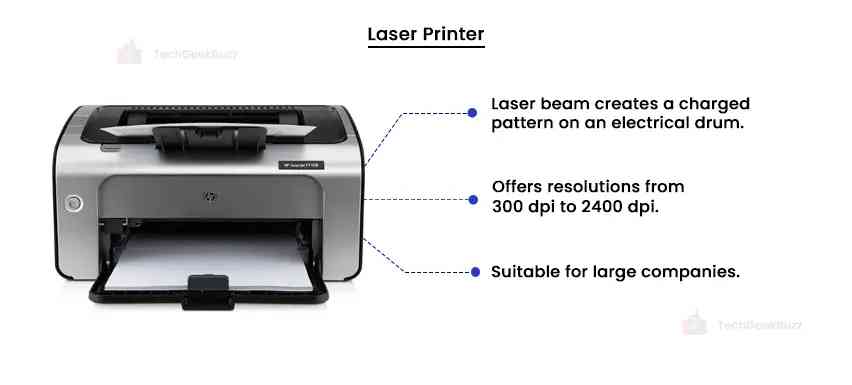
As the name suggests, laser printers utilize laser photocopier technology to print documents. When a user issues the print command, the laser beam uses electrical charges to draw the document on the selenium-coated electrical drum.
After the drum is fully charged, it is dipped and rolled into toner, which is dry ink powder. The charged particles on the drum pick up the ink powder in the shape of the desired image or text.
Later, the drum is pressed against the piece of paper, where the toner gets printed on paper with heat and pressure, leaving the drum. This creates a high-quality, detailed print of text or an image.
Laser printers can generate a print of resolution ranging from 300 dpi to 2400 dpi. The higher the dpi, the higher the quality of the prints. Large companies and enterprises often leverage laser printers due to their high quality and efficient printing process.
3. Thermal Printers
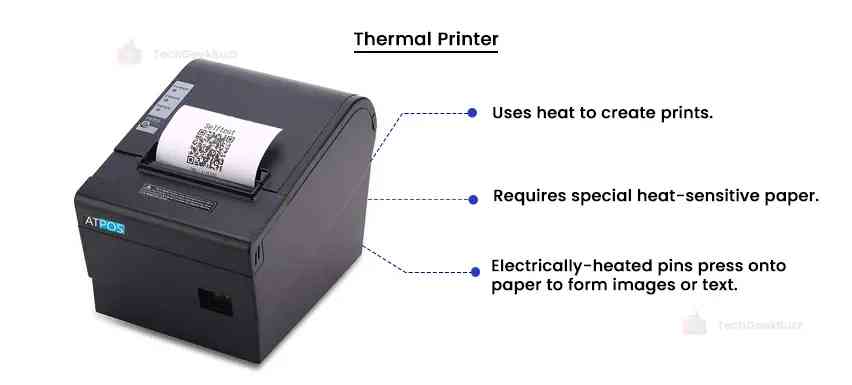
A thermal printer is a non-impact printer that leverages heat to generate a print of an image of text on paper. It pushes electrically-heated pins on heat-sensitive paper to form a print.
Thermal printers require a special kind of paper called heat-sensitive paper. When exposed to heat, it gets darker. So, the specific area becomes darker when heated pins press against the head-sensitive paper.
A thermal printer works with three major components:
- Thermal head: Produces heat to create characters or images on paper.
- Platen: A rubber roller that moves the paper.
- Spring: Applies pressure to hold the printhead and paper together.
Direct Thermal Printers and Thermal Transfer Printers are the two types of thermal printers.
- Direct Thermal Printer: It uses thermal paper coated with chemicals that change the color of the paper when subjected to heat. The printhead of a printer provides heat to the paper, which changes its color to dark, printing the desired text or image.
- Thermal Transfer Printer: It uses a ribbon and print media to create a desired print. The ribbon consists of wax, resin, or a combination of both.
These printers are widely used in airlines, banking, entertainment, grocery shops, and healthcare institutions for printing labels, receipts, and tickets. They require minimal maintenance and produce prints at a faster pace.
4. Dye-Sublimation Printers
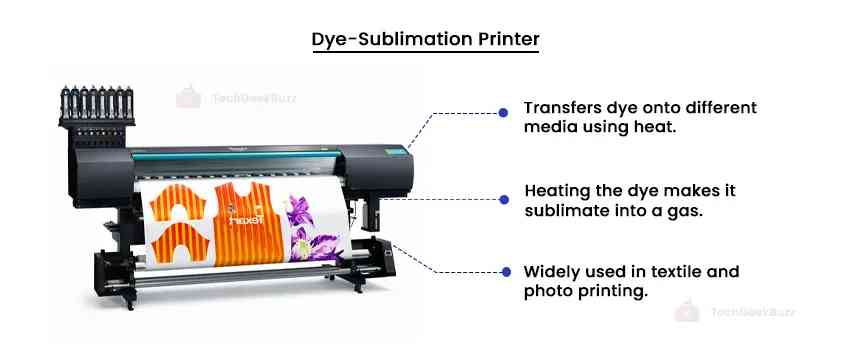
Also known as a dye-sub printer, a dye-sublimation printer transfers dye onto different printing media using heat. It uses a specialized ribbon holding solid dye.
The printer heats the dye, allowing it to sublimate (converting it into the gaseous state without going through the liquid state). The gas penetrates the surface of the printing medium, forming the desired print.
Dye-sublimation printers are widely used in textile printing, photo printing, etc. The dye on the prints does not fade and smudge.
Advantages and Disadvantages of Non-Impact Printers
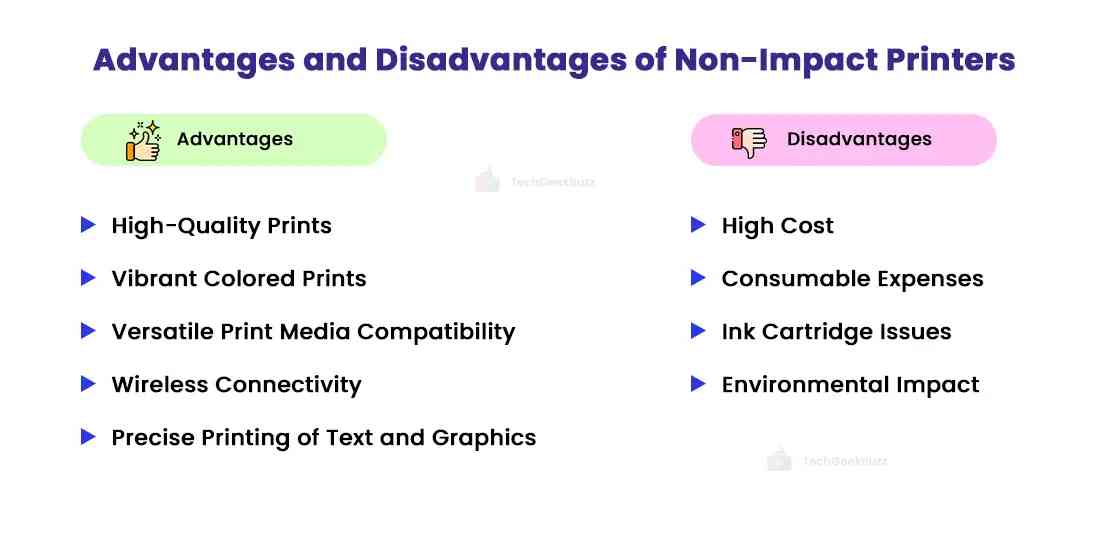
Let us now peek into the advantages and disadvantages of non-impact printers.
Advantages
- Non-impact printers produce high-quality, high-resolution prints with intricate details.
- They generate prints of images and graphics in vivid and vibrant colors.
- They support multifarious printing media, making them suitable for different printing purposes.
- Modern non-impact printers support wireless connectivity via Bluetooth. Hence, you can connect any Bluetooth-enabled device with a non-impact printer.
- The accuracy of text and graphics is what makes you rely on non-impact printers.
Disadvantages
- Non-impact printers are highly expensive compared to impact printers.
- You need to replace ink cartridges or toners and spend money on a special kind of paper for printing.
- Ink cartridges often run into several problems, such as clogged nozzles, ink leakage, poor print, or complete malfunction.
- If you buy a printer and dispose of it without using it, it negatively affects the environment.
Conclusion
This was all about a non-impact printer. Unlike an impact printer, a non-impact printer does not use the mechanism of striking the ink ribbon against the printing media using a hammer. Instead, it uses different printing technologies, like laser, inkjet, electrostatic, heat, sublimation, etc. As a result, non-impact printers are able to create high-resolution, vibrant prints without making any noise.
We hope we tried to explain a non-impact printer in an easy-to-understand way. If you have any doubts, feel free to comment below.
People are also reading:


![What is an Assembler? [Definition, Working, & Types]](/media/new_post_images/What_is_Assembler.jpg)
![What is I/O? [Types, Examples, & Methods]](/media/new_post_images/What_is_I_O.webp)

Leave a Comment on this Post